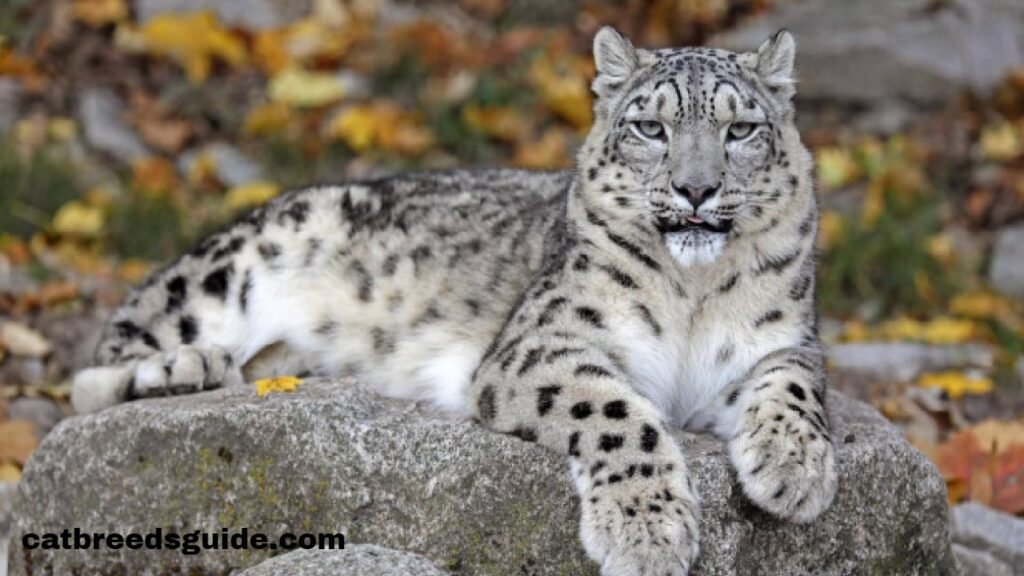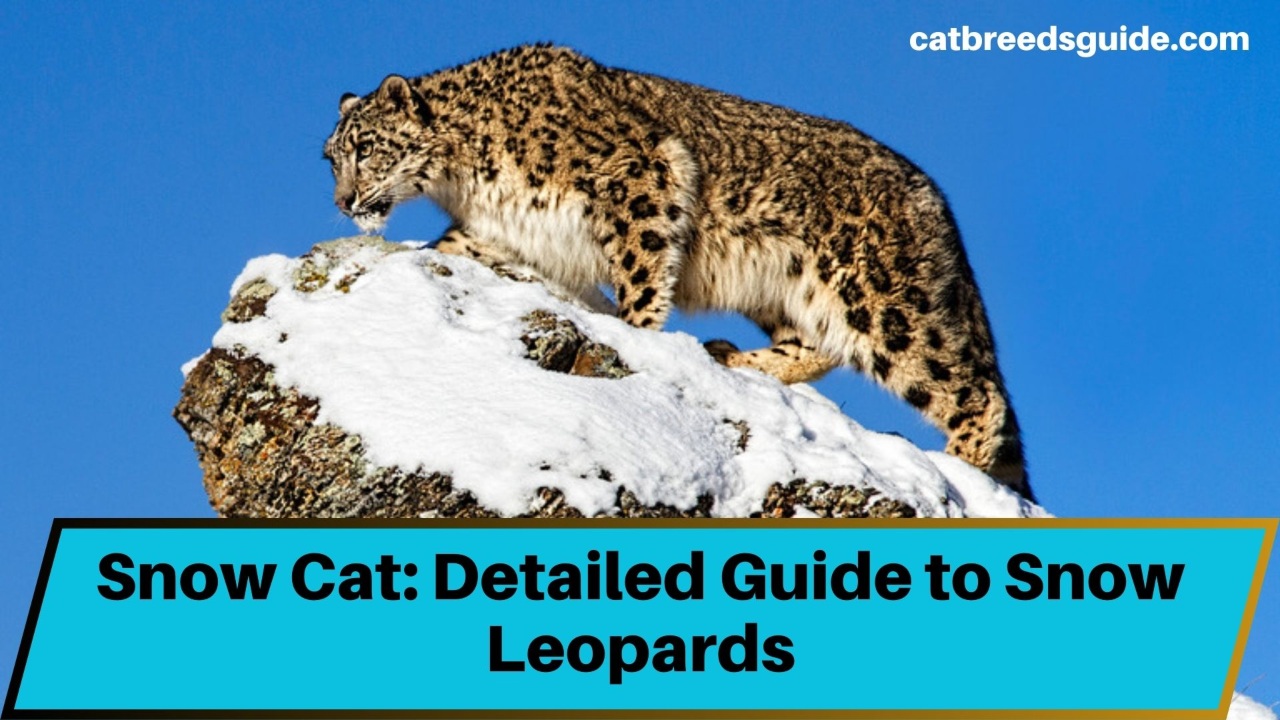Snow Leopards are a group of wild cats that are native to the snowy mountains of Asia. They are also known as snow leopards, ounce, or irbis. Snow cats are solitary animals that prefer to live in high-altitude areas with plenty of prey. They are excellent climbers and hunters, and they are well-adapted to the cold climate.

In this guide, we will explore the world of snow Leopards in detail. We will discuss their physical characteristics, behavior, habitat, and diet. We will also discuss the threats they face and what is being done to protect them.
Snow Leopards are the largest wild cats in the world after lions and tigers. They are about the size of a leopard, with a body length of about 5 feet and a weight of up to 150 pounds. Snow cats have thick, long fur that is white or light gray with black spots. This fur helps to camouflage them in the snow.

Snow Leopards have large, round heads with tufted ears. They have sharp teeth and claws that are used for hunting. Snow cats also have excellent vision and hearing, which helps them to hunt in the dark.
Where Do Snow Leopards Live?
Snow leopards, also known as snowcats, are large wild cats native to the snowy mountains of Asia. They are also referred to as ounce or irbis. Solitary in nature, snow leopards thrive in high-altitude areas abundant with prey. With exceptional climbing and hunting skills, they have evolved to adapt to the harsh cold climate of their habitats.

Snow leopards can be found in the following regions
- The Himalayas: Stretching across India, Nepal, China, Pakistan, and Bhutan.
- The Altai Mountains: Spanning across Mongolia, Russia, and China.
- The Tian Shan Mountains: Extending across China, Kyrgyzstan, Kazakhstan, and Uzbekistan.
- The Karakoram Mountains: Covering areas in Pakistan, China, and India.
- The Hindu Kush Mountains: Crossing through Afghanistan, Pakistan, and Tajikistan.
They predominantly inhabit areas with an average elevation of 4,000 to 17,000 feet, favoring locations characterized by steep, rocky slopes with an abundance of prey such as marmots, pikas, and wild goats. Snow leopards are also known to reside in forests, grasslands, and alpine meadows.

Playing a crucial role in the mountain ecosystem, snow leopards help control the population of prey animals, contributing to the overall health of the ecosystem. Additionally, they serve as a popular tourist attraction, generating revenue for local communities.
Threats to Snow Leopards
Snow leopards are classified as a vulnerable species by the International Union for Conservation of Nature (IUCN). The primary threats to snow leopards include:
- Poaching: Hunted for their valuable fur.
- Habitat Loss: Resulting from climate change, development, and livestock grazing.
- Conflict with Humans: Occurs when snow leopards prey on livestock, leading to conflicts with human populations.

Our Other Related Articles
Conservation Efforts
Various conservation initiatives are in place to protect snow leopards, including:
- Poaching Enforcement: Governments are intensifying efforts to combat the illegal hunting of snow leopards.
- Habitat Protection: Collaborative efforts by governments and conservation organizations to preserve snow leopard habitats.
- Education: Conservation organizations are actively educating the public on the significance of snow leopards and the threats they face.
By joining forces, we can contribute to ensuring the survival of these remarkable animals.
| Property | Information |
|---|---|
| Scientific Name | Panthera uncia |
| Common Names | Snow Leopard, Ounce, Irbis |
| Habitat | Mountainous regions of Central and South Asia |
| Range | Himalayas, Altai Mountains, Tian Shan, Karakoram, Hindu Kush |
| Elevation | 4,000 to 17,000 feet |
| Physical Features | Spotted or marbled coat, robust build, long tail |
| Prey | Marmots, pikas, wild goats, sheep, and small mammals |
| Behavior | Solitary and elusive, excellent climbers and hunters |
| Conservation Status | Vulnerable (IUCN Red List) |
| Threats | Poaching, habitat loss, human-wildlife conflict |
| Conservation Efforts | Anti-poaching measures, habitat protection, public education |
| Role in Ecosystem | Regulates prey population, maintains ecological balance |
| Popularity | Attracts tourists, contributes to local economies |
| Notable Features | Adapted to harsh, cold climates, well-camouflaged fur |
Are Snow Leopards Suitable for Domestication?
Snow leopards are large, wild cats that are native to the snowy mountains of Asia. They are also known as ounce, irbis, or snow lion. Snow leopards are solitary animals that prefer to live in high-altitude areas with plenty of prey. They are excellent climbers and hunters, and they are well-adapted to the cold climate.
While snow leopards are beautiful and majestic animals, they are not suitable for domestication. They are wild animals with natural instincts that make them unsuitable for life in a home.

One of the biggest challenges of domesticating a snow leopard is their prey drive. Snow leopards are carnivores and they are naturally inclined to hunt. In a home environment, this could lead to aggression towards people and other animals.
Another challenge of domesticating a snow leopard is their need for exercise. Snow leopards are active animals and they need plenty of space to roam. In a home environment, they may become bored and restless, which could lead to destructive behavior.
Finally, snow leopards are expensive to care for. They require a special diet, veterinary care, and a large enclosure.
If you are considering getting a snow leopard as a pet, it is important to do your research and understand the challenges involved. Snow leopards are wild animals and they should not be kept as pets.
Here are some of the reasons why snow leopards are not suitable for domestication
- Prey drive: Snow leopards are carnivores and they have a natural instinct to hunt. In a home environment, this could lead to aggression towards people and other animals.
- Need for exercise: Snow leopards are active animals and they need plenty of space to roam. In a home environment, they may become bored and restless, which could lead to destructive behavior.
- Cost: Snow leopards are expensive to care for. They require a special diet, veterinary care, and a large enclosure.
**If you are interested in learning more about snow leopards, there are a number of resources available. You can visit a local zoo or wildlife sanctuary, or you can do research online.
History of Snow Leopards
Snow leopards are large, wild cats that are native to the snowy mountains of Asia. They are also known as ounce, irbis, or snow lion. Snow leopards are solitary animals that prefer to live in high-altitude areas with plenty of prey. They are excellent climbers and hunters, and they are well-adapted to the cold climate.

The history of snow leopards is long and complex. They have been a part of the Asian landscape for thousands of years.
Early history
The earliest evidence of snow leopards dates back to the Pleistocene epoch, which lasted from about 2.6 million to 11,700 years ago. During this time, snow leopards were widespread throughout Asia, from the Himalayas to the Altai Mountains.
Modern history
The modern history of snow leopards began in the 19th century. During this time, snow leopards were hunted for their fur, which was considered to be valuable. This led to a decline in the snow leopard population.

In the 20th century, the snow leopard population continued to decline due to habitat loss and conflict with humans. Habitat loss is a major threat to snow leopards because they need large areas of land to survive. Conflict with humans occurs when snow leopards prey on livestock or when humans encroach on their habitat.
How Many Snow Leopards Are There in the World?
The exact number of snow leopards in the world is unknown, but it is estimated that there are between 4,000 and 6,500 individuals. This number is based on surveys and camera trap data, but it is difficult to get an accurate count of a secretive and elusive species.










